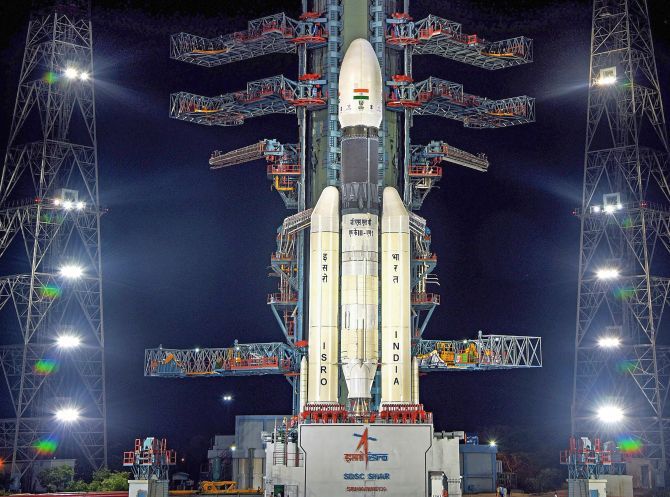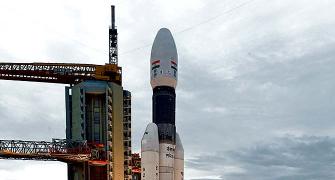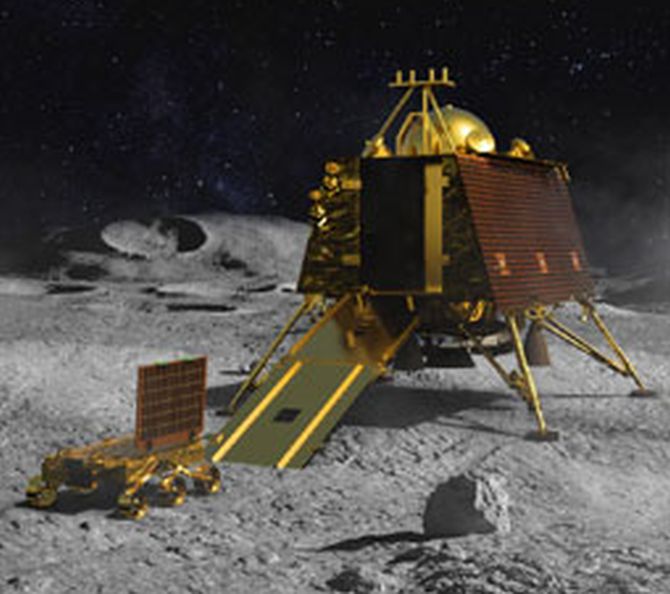'Isro needs to turn itself into a planning, contracting, and contract-monitoring organisation.
'This will translate public expenditure into greater knowledge spillovers into India, and greater achievements on the dark side of the moon,' says Ajay Shah.

The immediate motivation for creating the Indian Space Research Organisation has subsided: The fruits of their labour can be purchased on the world market.
Landing a craft on the moon has zero practical payoff.
The gains from doing this now lie entirely in its impact on capacity building in India.
To the extent that Isro operates in isolation, the gains for society are small.
In order to obtain strong spillovers from public expenditures for society at large, Isro needs to become like Nasa, a contracting organisation.
There was a time when we in India built Isro for the purpose of obtaining tangible benefits from space exploration.
While those considerations were appropriate at the time, that phase has subsided.
Commercial activities, such as communications or remote sensing, are now amply feasible through the global space industry.
The quality and price of commercial offers worldwide are now astonishingly good, and Indian users can easily buy these services.
Military objectives have been achieved and transferred to the armed forces, which now know how to send a nuclear missile to a desired destination, or a low-orbit spy satellite to photograph Xi Jinping on his morning jog.
Self-reliance is less critical than it used to be: Spy-satellite services can be purchased in the world market, which may exceed domestic capabilities.
Landing a craft on the moon is thrilling, but it generates no tangible gains for India.
How do we justify budgetary expenditures on Isro?
A lot of money is being spent at Isro, but how do we ensure that it is being spent wisely and that the maximum gains for society are achieved?
The key insight lies in thinking about spillovers of knowledge.
It is worth putting public money into space exploration owing to the spillovers that it generates.
The design of institutional arrangements should be done in a way that maximises those spillovers.
At one extreme is a hermetically sealed Isro.
Public money goes into Isro, a team of engineers at the organisation alone builds a craft, they achieve the knowledge of how to land a craft on the moon, but they are completely cut off from the Indian mainstream, particularly owing to the secrecy associated with this work.
In this scenario, the gains for India from this expenditure are small.
At the other extreme is Nasa.
Before the feats of engineering at Nasa came the feats of public policy and public administration, in the “acquisition process”.
Nasa has rarely built space equipment.
The staff of Nasa are not engineers who build equipment; they are civil servants who do contracting, to private firms and private universities, which hire engineers.
From 1958 to 1965, the real achievements at Nasa were in developing procedures which would spread Nasa funds across the economy.
In 1960, Nasa was contracting out $300 million.
In 1968, the year before the Apollo 11 landing on the moon, it was contracting out $4 billion, of which a quarter was going outside the US.
The real impact of Nasa upon knowledge, in the US and outside it, lay in spurring capabilities in all the persons who got these contracts.
The money spent on Nasa was well worth it, not because it is inspiring seeing men walking on the moon but because thousands of ideas flowed into the technological capabilities of firms in the US and outside it.
The “Jet Propulsion Laboratory” is Nasa’s primary planetary spacecraft centre, which has 6,000 employees and a fluctuating population of a few thousand short-term staff.
It is operated by a private university -- Caltech -- which is paid $3 billion a year by Nasa.
The JPL produces photographs of Jupiter, but it yields much more: It fuses into the broader knowledge at Caltech and thus ultimately into the overall country.
Three programmes are underway at Nasa, which gets private firms to build capabilities.
The “Commercial crew program” asks private firms to carry astronauts to and from the International Space Station.
These contracts have gone to SpaceX and Boeing.
The “Commercial cargo program” has a large number of robotic cargo flights by SpaceX and Northrop Grumman to the ISS.
The “Commercial lunar payload services” programme has two contractors, who are being paid about $80 million each.
Astrobotic’s Peregrine lander will fly up to 14 Nasa payloads to a location on the moon, and Intuitive Machine’s Nova-C lander will take up to five Nasa payloads to another location on the moon.
These three dimensions of contracting will give thrilling videos.
More importantly, they will create capable organisations in the private sector, from where knowledge will spill over into society and the world more widely.
Drawing on these ideas, Isro needs to turn itself into a planning, contracting, and contract-monitoring organisation.
This will translate public expenditure into greater knowledge spillovers into India, and greater achievements on the dark side of the moon.
A key concern about the Indian defence, space, and nuclear programmes is that of cost efficiency.
As an example, nuclear plants made in India are much less cost-effective than the best worldwide.
This problem may be present in space technology also.
It is hard to correctly account for all the expenditures that are going into space research, and assess cost-efficiency.
In order to solve this problem, the things that are understood -- like building certain kinds of satellites or rockets -- should be spun off into private firms which will then compete on the global market in a purely commercial way.
We have vividly seen this in the US, where private firms now own the full design and development of vehicles, and Nasa is just renting rides to the ISS.
Public money on weather satellites will be spent more efficiently when there are multiple private firms (Indian and foreign) competing for the services that the India Meteorological Department requires, as opposed to a clubby environment where Isro obtains budgetary allocations for doing the IMD’s work.
Isro should divest itself of the easy terrain, and concentrate on building the next level of knowledge -- not by hiring engineers but through intelligent contracting.
Ajay Shah is a professor at the National Institute of Public Finance and Policy, New Delhi.











